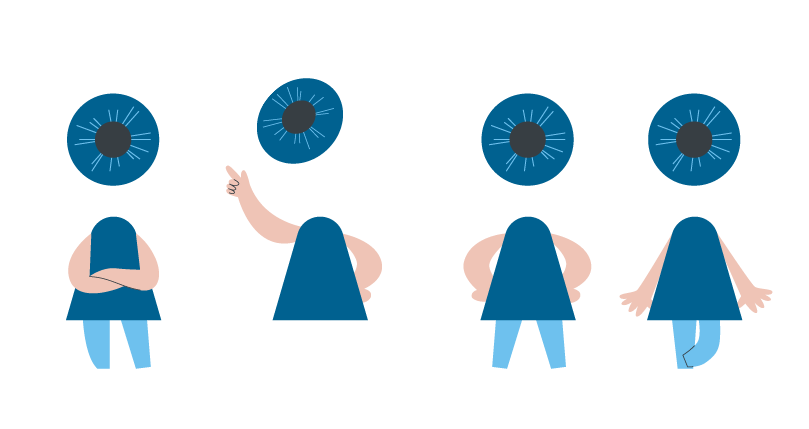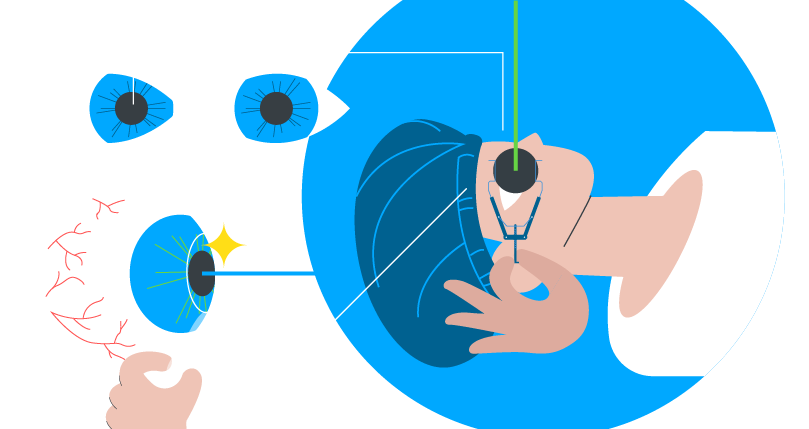Strabismus, or lazy eye, is a condition where the eyes are not aligned properly and point in different
directions. [1]
It affects 1-4% of the global population. [2]
While strabismus can be treated with glasses, patches, or even surgery, some people may wonder if
laser eye surgery could also be an option.
In this post, you'll discover whether laser eye surgery can fix strabismus, and what you need to know
before considering this type of treatment.
Let's dive right in:
What is lazy eye?

Lazy eye, is known as two things:
Amblyopia: This is the medical term for lazy eye. It is a condition where the brain and the eye are not
working together properly, leading to reduced vision in one or both eyes. [3]
Strabismus: Common people often use 'lazy eye' to mean strabismus. Strabismus is the
misalignment of the two eyes. [4]
While your doctor might think of a 'lazy eye' as amblyopia - most people think of lazy eye as
strabismus.
So in this post we're focusing on the latter.
Is a lazy eye treatable?
Strabismus is known as being a fully treatable condition. So yes, a lazy eye can be treated with the
right procedure.
What causes a lazy eye?
The underlying reason why strabismus develops is not yet clear. Researchers have identified pre-
mature birth as a key risk [5], and genetic reasons as well. [6]
It's important to note that lazy eye is not caused by laziness or lack of effort on the part of the
affected individual.
What is LASIK eye surgery?

LASIK stands for Laser-Assisted In Situ Keratomileusis. It is a type of refractive surgery that uses a
laser to reshape the cornea of the eye, with the goal of improving vision and reducing the need for
glasses or contact lenses.
The procedure involves:
Creating a thin, hinged flap on the surface of the cornea, which is then lifted to expose the
underlying tissue.
A computer-controlled laser is then used to reshape the cornea by removing a precise amount of
tissue.
The corneal flap is then repositioned, where it adheres naturally without the need for stitches.
LASIK is typically used to correct nearsightedness, farsightedness, and astigmatism. The procedure is
usually performed on an outpatient basis and takes only a few minutes per eye. Most people
experience a significant improvement in vision within a few days after surgery.
Who should not do Lasik eye surgery?
While LASIK eye surgery is a safe and effective procedure for many people, there are certain people
that are not a good LASIK eye surgery candidate:
Age: LASIK is generally not recommended for people under the age of 18, as their eyes may still be
changing.
Pregnancy or nursing: Hormonal changes during pregnancy and nursing can affect vision, so LASIK is
not recommended during these times.
Certain medical conditions: People with certain medical conditions, such as autoimmune diseases,
diabetes, or glaucoma, may not be good candidates for LASIK.
Eye diseases or disorders: LASIK may not be recommended for people with cataracts, keratoconus,
or severe dry eye syndrome.
Thin or irregular corneas: LASIK requires a certain amount of corneal tissue to be removed in order
to reshape the eye, so people with very thin or irregular corneas may not be good candidates for the
procedure.
Unstable vision: People with unstable vision, such as those with frequent changes in their glasses or
contact lens prescription, may not be good candidates for LASIK.
Will LASIK correct a lazy eye?
With a lazy eye, are you a possible lasik eye surgery candidate? Yes, but typically - LASIK surgery is
not recommended for the treatment of lazy eye (strabismus).
This is because strabismus is a condition that affects your eye muscles and your visual cortex [7].
Whereas the LASIK procedure corrects the refractive errors of your eyes (it's a vision correction
surgery).
Now, the untreated refractive errors may have worsened the strabismus (assuming no glasses and
contact lenses were used before).
And improving vision in one eye that was previously having an uncorrected refractive error (vision
problems) might indeed help - both for lazy eye and strabismus. [8]
So while LASIK may not be the first-line treatment for strabismus or amblyopia - it might be able to
help the affected eye with poor vision.
What is the best way to correct lazy eye?
Your eye doctor will agree that the absolute best treatment for lazy eye is 'lazy eye surgery'. [9]
Lazy eye surgery adjusts the eye muscles.
LASIK eye surgery adjusts the cornea (the front of the eye itself).
While lazy eye surgery is a routine procedure, [10] the price tag can often seem prohibitive.
What is an alternative to lazy eye surgery?
The best alternative for strabismus (lazy eye) with small angles is vision therapy. [11]
Vision therapy is known to being an effective treatment for lazy eye - and doesn't contain any of the
risk normal surgery has.
The only two downsides to vision therapy is that:
- It takes time - and:
- It's super expensive as well.
With our vision therapy software, we wanted to improve the second condition. Our Lazyeyefix Ai
software will help you improve and train your lazy eye in the comfort of your home.
We're the only vision therapy option with a free trial - and you can try our revolutionary software for
free by clicking the link below:
Windows: https://dashboard.lazyeyefix.com/download/w/
MacOS: https://dashboard.lazyeyefix.com/download/m/
References:
[1] Strabismus by Cleveland Clinic:https://my.clevelandclinic.org/health/diseases/15065-strabismus-crossed-eyes
[2] Prevalence of Strabismus and Its Impact on Vision-Related Quality of Life: Results from the
German Population-Based Gutenberg Health Study:https://www.sciencedirect.com/science/article/abs/pii/S0161642020301913
[3] The Amblyopia Treatment Studies: Implications for Clinical Practice:https://www.ncbi.nlm.nih.gov/pmc/articles/PMC5396957/
[4] Strabismus by Cleveland Clinic:https://my.clevelandclinic.org/health/diseases/15065-strabismus-crossed-eyes
[5] Born Too Soon - The Global Action Report on Preterm Birth by WHO:http://apps.who.int/iris/bitstream/handle/10665/44864/9789241503433_eng.pdf?sequence=1
[6] Genetic Basis of Congenital Strabismus:https://jamanetwork.com/journals/jamaophthalmology/fullarticle/817192
[7] Adaptation of the Central Retina for High Acuity Vision: Cones, the Fovea and the Avascular Zone:https://www.ncbi.nlm.nih.gov/pmc/articles/PMC3658155/
[8] Neural plasticity in adults with amblyopia.https://www.ncbi.nlm.nih.gov/pmc/articles/PMC39113/
[9] Strabismus, Strabismus Surgery, and Reoperation Rate in the United States: Analysis from the IRISRegistry: https://pubmed.ncbi.nlm.nih.gov/29779683/
[10] Surgery is a routine procedure:https://www.aao.org/eye-health/tips-prevention/lazy-eye-surgery-facts
[11] Randomized clinical trial of treatments for symptomatic convergence insufficiency in children: https://pubmed.ncbi.nlm.nih.gov/18852411/






